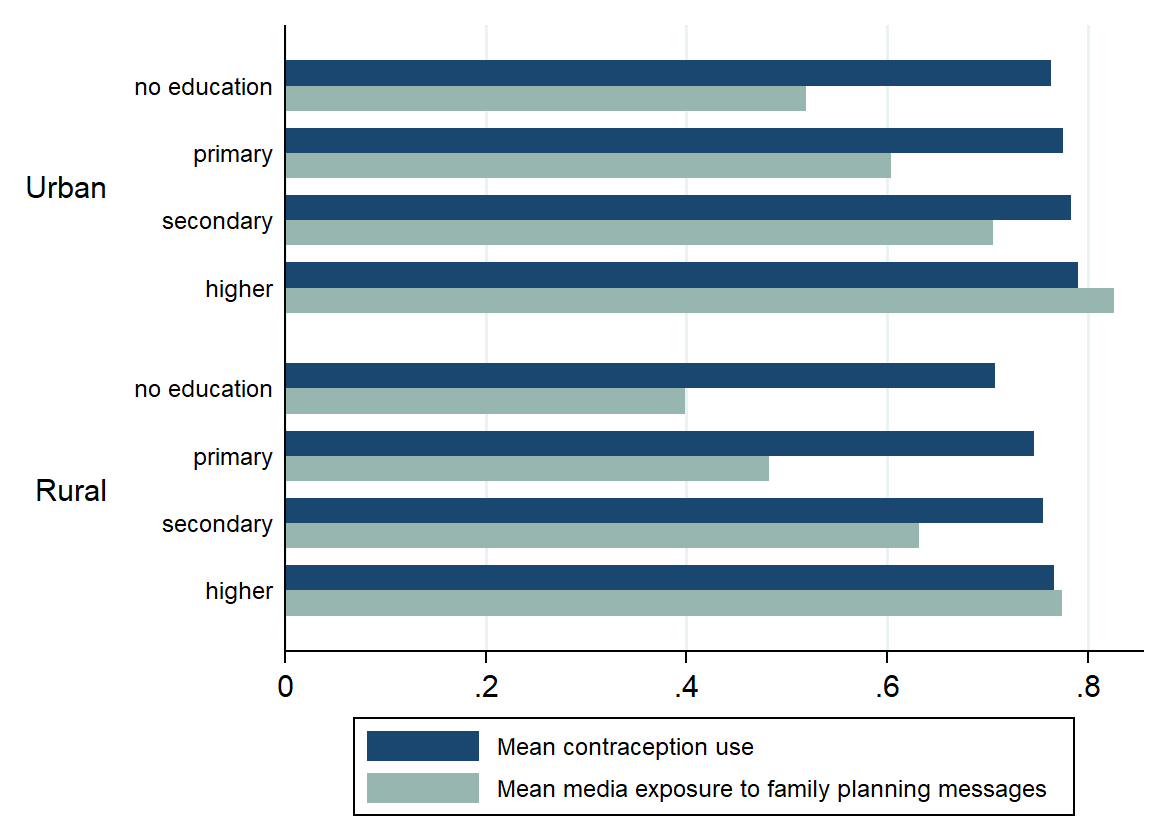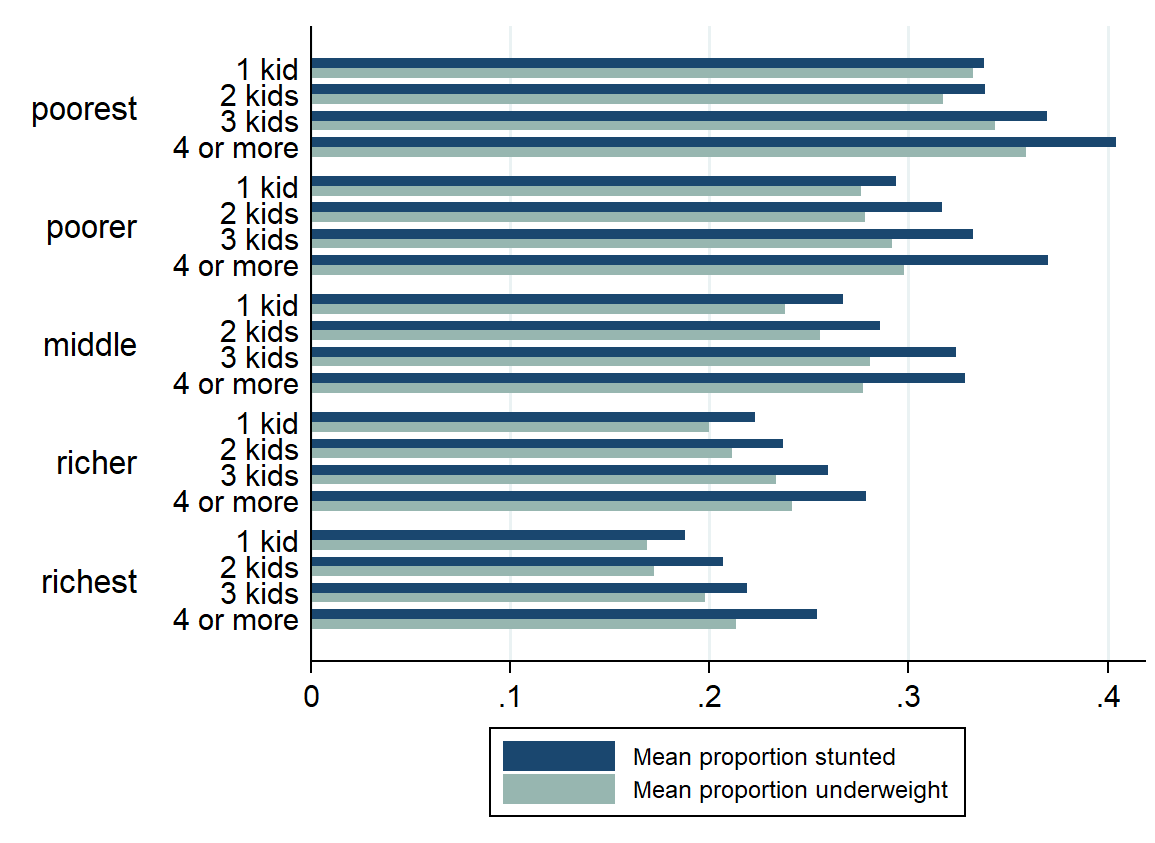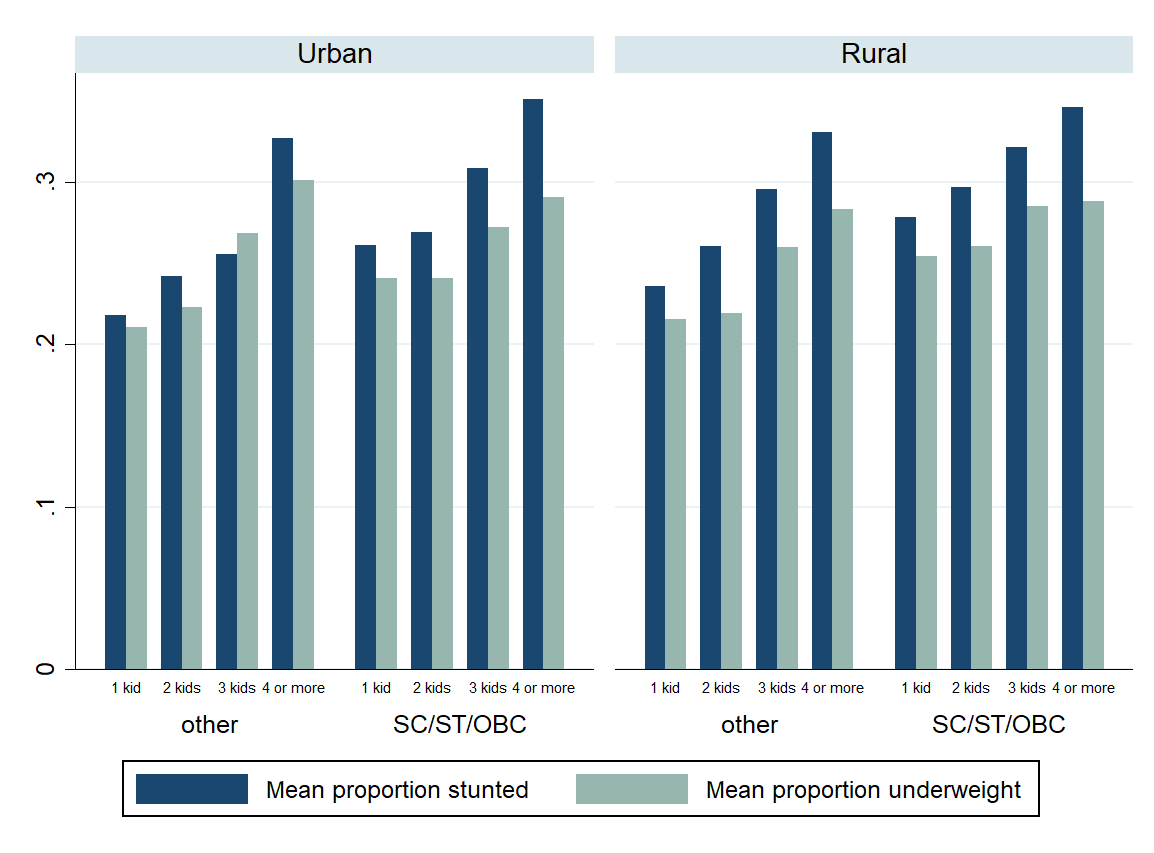
Economic theory predicts that smaller families can lead to healthier children. Evidence from India shows contraception plays a vital role in reducing child malnutrition, potentially by enabling parents to invest more resources in each child.
According to the latest Joint Child Malnutrition Estimates from 2022 (UNICEF, WHO 2021), 22.3% (148 million) of children under five are too short for their age, 6.8% (45 million) are too thin for their height, and 5.6% (37 million) are overweight. Despite decades of investment and government initiatives like the National Food Security Act, which includes programmes such as Integrated Child Development Services (ICDS) and the Mid-Day Meal Scheme (MDMS) aimed at combatting child malnutrition (Chakraborty and Jayaraman 2022), India remains home to a third of the world's stunted children, with undernutrition contributing to half of all under-five mortality.
The health and economic consequences of malnutrition on children
Malnutrition has been well-established as a cause of long-term physiological harm and has been strongly associated with impaired cognitive development, lower academic achievement, and behavioural issues in children. Its economic ramifications are equally significant, resulting in diminished human capital and productivity, which could imply a loss of up to 17% of GDP by perpetuating poverty in severely affected nations (Dione et al. 2013). Evidence also suggests that children from larger families with more siblings or higher birth orders have poorer health, worse human capital outcomes, and weaker cognitive development (Blake 1981, Silles 2010). These patterns are explained by the quantity-quality (QQ) trade-off theory or the resource dilution hypothesis, which posits that as family size increases, parental resources per child, both time and material, are spread thinner (Becker and Lewis 1973, Becker and Tomes 1976). Drawing on the idea that limiting fertility rates could allow greater attention, care, and resource allocation per child, in our paper (Mookerjee et al. 2023), we investigate the linkages between contraception use and child malnutrition indicators in India.
There are large benefits of family planning and contraception both for mothers and their children
Extant research highlights the far-reaching benefits of family planning and access to contraception, including improvements in maternal health through fewer total births, reduced unintended pregnancies, extended birth spacing, and decreased rates of preterm births and low birth weight (Molitoris 2017, Rau et al. 2021, Voena 2019). Long-term impacts of better family planning practices on the enhancement of women's assets, earnings, body mass indices (BMI), as well as her children's schooling and BMI have also been noted in Canning and Schultz (2012). Ironically, while India was the first country in the world to launch a National Program for Family Planning in 1952, stunting in children under five has increased in 13 out of 22 states since 2015-16, and wasting (low weight-to-height) has increased in 12 states. This raises questions about the efforts addressing such chronic health issues and leads us to explore the channels that explain malnutrition in India to better inform potential solutions.
Examining how contraception impacts child nutrition in India
Utilising the latest round of the National Family Health Survey (NFHS-5) for India conducted in 2019-21, we make a novel attempt to estimate the causal impact of contraceptive use on child nutrition indicators. We use the individual-level data on women of reproductive age and the corresponding information on all their children under the age of 5. We examine the impact of whether a couple has ever used any contraceptive measures to delay pregnancy on children’s height-for-age z-score (HAZ), and weight-for-age z-score (WAZ), commonly used in nutritional surveillance in order to keep track of a population’s health, spot problems early and take necessary action for improvement. The primary econometric challenge in estimating this impact is that a couple’s contraception use can be endogenous for various reasons. There can be measurement error due to misreporting. There may also be reverse causality if the nutritional status of older kids impacts the contraception decisions of couples for future pregnancies. To alleviate such concerns, we exploit exogenous variation in the average district-level exposure of women to family planning messages through mass media, including television, radio, and newspaper, as an instrument to explain the couple’s contraception use. Figure 1, based on NFHS 2019-20, establishes the relevance of our instrument by illustrating a high correlation between average exposure to family planning messages through different sources of mass media and the average contraception use by couples. Contraception use and media exposure also increase with education, both in rural and urban areas.
Figure 1: Contraception use and media exposure to family planning (by education and geographic location)

We find robust evidence that, having controlled for a host of mother, child, and household characteristics, contraceptive use by parents, instrumented by average exposure to family planning messages through mass media, leads to a 1.4 standard deviation (SD) increase in a child's height-for-age z-score and a 0.47 SD increase in their weight-for-age z-score. A height-for-age and weight-for-age score of zero means the child matches the reference population average and negative scores indicate stunting or being underweight. Therefore, increases in these scores suggest improvements in child health. Additionally, the likelihood of a child being stunted (underweight) falls by 17.9 percentage points (10.9 percentage points) respectively with a couple’s use of contraception.
Using contraception reduces family size and improves per-child resource allocation in India
We provide evidence that the quantity-quality trade-off is a potential mechanism driving our results for India. This indicates that with family planning measures and consequently fewer children, parents are more effectively able to invest resources towards their existing children. Figure 2 illustrates that as the number of children increases in the family, the average proportion of stunted and underweight children per household increases, although the effects are much worse for poorer families in India. From Figure 3, we find additional evidence that regardless of rural or urban areas, across castes, more kids result in worse child health. In our study, we establish that contraception use leads to a significant reduction in household size. Furthermore, an exogenous increase in household size driven by twins/multiple births indeed depletes a child's height-for-age z-score and weight-for-age z-score. Our findings suggest that policies that promote the use of contraceptives and encourage sound practices of family planning may aid India in reaping non-negligible benefits in terms of child health in conjunction with fulfilling its target of population stabilisation.
Figure 2: Child health indicators by family size and wealth index

Figure 3: Child health indicators by family size, caste, and geographic location

Policy recommendations: Expanding uptake, acceptability and access to contraception
We also find consistently important effects of the use of contraceptives on children's anthropometric measures utilising the NFHS-4 for 2015-16. As such, we assert that these results ought to serve as a benchmark for policy discussions. With India sliding down the ranks in the Global Hunger Index from 94 to 107 out of 121 countries in 2022, discussions around hunger and malnutrition are of paramount importance. Considering that better nutritional outcomes for children eventually lead to better human capital accumulation, improved productivity, and reduced healthcare costs, we underline the importance of family planning measures in tackling child ill-health. While better sanitation, food security, and maternal healthcare have been examined as important determinants of child health in the literature, our paper calls for greater focus on family planning measures, specifically through the encouragement of contraceptive use for improved child nutritional status in countries that may face both high populations as well as the triple burden of child malnutrition.
Our findings also indicate that these family planning measures may have greater positive effects on children from marginalised and poorer households in rural areas. Additionally, the uptake, acceptability, and access to contraception, along with exposure to family planning messages, tend to be lower among less educated populations. Therefore, directing efforts toward these groups could yield significant improvements in children's health outcomes.
References
Becker, G S, and H G Lewis (1973), “On the interaction between the quantity and quality of children,” Journal of Political Economy, 81(2, Part 2). https://doi.org/10.1086/260166.
Becker, G S, and N Tomes (1976), “Child endowments and the quantity and quality of children,” Journal of Political Economy, 84(4, Part 2). https://doi.org/10.1086/260536.
Blake, J (1981), “Family size and the quality of children,” Demography, 18(4). https://doi.org/10.2307/2060941.
Canning, D, and T P Schultz (2012), “The economic consequences of reproductive health and family planning,” The Lancet, 380(9837). https://doi.org/10.1016/S0140-6736(12)60827-7.
Chakraborty, T, and R Jayaraman (2022), “Midday meals in India improve children’s learning outcomes,” VoxDev.
Dione, J, S W Omamo, A Diop, and M S Kaloko (2013), “The cost of hunger in Ethiopia. Implications for the growth and transformation of Ethiopia. The social and economic impact of child undernutrition in Ethiopia: Summary report,” African Union Commission, World Food Programme, United Nations Economic Commission for Africa, Vol. 1.
Molitoris, J (2017), “The effect of birth spacing on child mortality in Sweden, 1878–1926,” Population and Development Review, 43(1). https://doi.org/10.1111/padr.12050.
Mookerjee, M, M Ojha, and S Roy (2023), “Family planning practices: Examining the link between contraception and child health,” Economic Modelling, 129. https://doi.org/10.1016/j.econmod.2023.106562.
Rau, T, M Sarzosa, and S Urzúa (2021), “The children of the missed pill,” Journal of Health Economics, 79. https://doi.org/10.1016/j.jhealeco.2021.102496.
Silles, M A (2010), “The implications of family size and birth order for test scores and behavioral development,” Economics of Education Review, 29(5). https://doi.org/10.1016/j.econedurev.2010.02.004.
UNICEF, WHO, and W B G (2021), “Joint child malnutrition estimates,” WHO, 24(2).
Voena, A (2019), “Reducing fertility in sub-Saharan Africa,” VoxDev.


